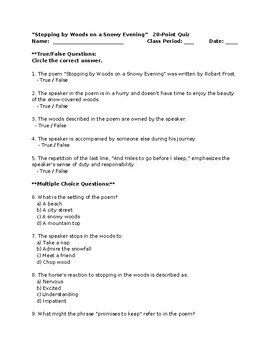"Stopping by Woods on a Snowy Evening" by Robert Frost - Test / Quiz
- Word Document File
Description
This is a test about Robert Frost's poem, "Stopping by Woods on a Snowy Evening", including true / false, multiple choice, and short answer essay questions. An ANSWER KEY is included. Possible key points for short answer essay prompts are also included. I use the essay prompts and the possible key points for essay choice questions and for my assessment of their expository essay as well.
This comprehensive test delves into the poem's intricate themes, characters, and societal critiques, offering a challenging and insightful exploration. Elevate your students' understanding of this timeless classic and use and reuse this from year to year or for your absent students' make-up test if they miss your discussion of the poem. I've used it as an oral make-up test as well because it goes fast for a poem make up.
I also use this as my start to begin planning my poetry study discussion questions that we'll use during class to make sure we cover the points I want them to pick up from the reading and also what should be included in their essays if they choose to write on this poem. If we cover the main points in our class or group discussions, they should have more than enough knowledge to write thoughtful work if they write on this poem.
The test is 2 pages, and the answer key is 3 as it includes a possible answer and key points for each short answer prompt.





